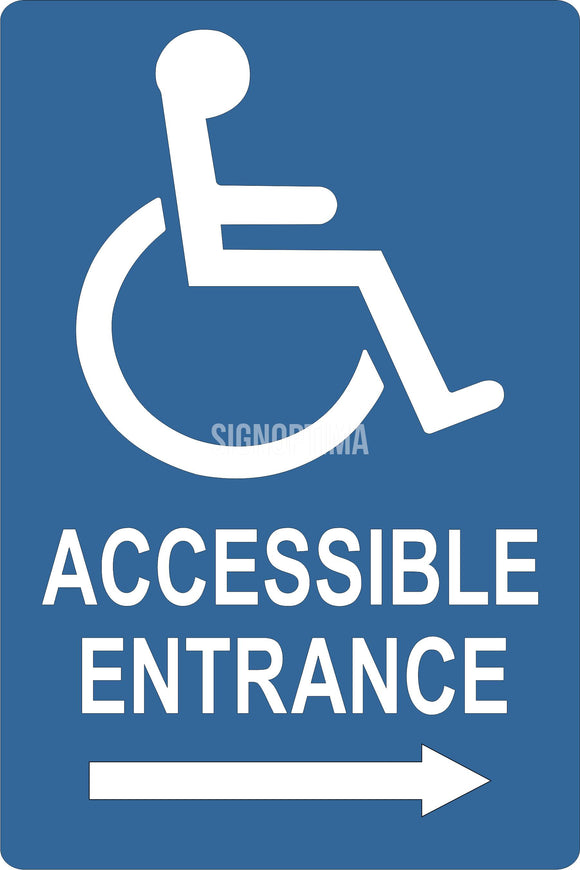The Duty of ADA Signs in Abiding By Accessibility Requirements
The Duty of ADA Signs in Abiding By Accessibility Requirements
Blog Article
Checking Out the Key Features of ADA Signs for Boosted Accessibility
In the world of ease of access, ADA indications serve as silent yet effective allies, making certain that spaces are navigable and comprehensive for individuals with impairments. By integrating Braille and responsive components, these indications damage barriers for the aesthetically damaged, while high-contrast color design and understandable typefaces accommodate diverse visual demands. Furthermore, their calculated placement is not approximate however rather a calculated effort to assist in smooth navigation. Past these functions lies a much deeper narrative concerning the advancement of inclusivity and the continuous dedication to producing fair rooms. What extra could these indications indicate in our quest of global availability?
Relevance of ADA Compliance
Making sure conformity with the Americans with Disabilities Act (ADA) is vital for promoting inclusivity and equivalent access in public rooms and offices. The ADA, passed in 1990, mandates that all public facilities, companies, and transport services accommodate people with disabilities, ensuring they take pleasure in the very same legal rights and opportunities as others. Compliance with ADA requirements not just meets lawful responsibilities but also boosts a company's track record by demonstrating its dedication to variety and inclusivity.
One of the crucial elements of ADA conformity is the application of available signs. ADA indicators are created to guarantee that individuals with specials needs can conveniently navigate through rooms and structures.
In addition, sticking to ADA regulations can reduce the risk of potential fines and legal effects. Organizations that fall short to abide by ADA guidelines might encounter fines or claims, which can be both harmful and economically burdensome to their public image. Therefore, ADA conformity is important to promoting a fair environment for everybody.
Braille and Tactile Elements
The unification of Braille and responsive aspects right into ADA signs symbolizes the principles of availability and inclusivity. It is typically put underneath the matching message on signs to make sure that people can access the info without visual assistance.
Tactile aspects prolong beyond Braille and consist of increased symbols and characters. These elements are made to be noticeable by touch, allowing individuals to identify area numbers, bathrooms, departures, and various other important locations. The ADA sets specific standards relating to the size, spacing, and positioning of these responsive elements to optimize readability and ensure uniformity across different atmospheres.

High-Contrast Color Design
High-contrast color schemes play a pivotal role in enhancing the presence and readability of ADA signs for people with aesthetic impairments. These plans are crucial as they make best use of the distinction in light reflectance between text and background, making certain that signs are quickly noticeable, even from a distance. The Americans with Disabilities Act (ADA) mandates the use of certain shade contrasts to accommodate those with limited vision, making it an essential aspect of conformity.
The efficacy of high-contrast shades hinges on their capability to stand out in different lights conditions, including dimly lit straight from the source atmospheres and locations with glow. Normally, dark message on a light history or light text on a dark background is utilized to attain ideal comparison. For example, black text on a yellow or white history supplies a plain visual distinction that assists in quick recognition and understanding.

Legible Fonts and Text Size
When taking into consideration the layout of ADA signs, the selection of legible typefaces and proper text dimension can not be overstated. These components are important for ensuring that signs are obtainable to individuals with visual impairments. The Americans with Disabilities Act (ADA) mandates that fonts have to be not italic and sans-serif, oblique, script, very ornamental, or of uncommon form. These needs assist guarantee that the text is quickly readable from a distance and that the personalities are distinguishable to diverse audiences.
The dimension of the text also plays a critical role in ease of access. According to ADA guidelines, the minimum text height need to be 5/8 inch, and it should increase proportionally with seeing range. This is especially vital in public rooms where signage demands to site link be read rapidly and properly. Consistency in text dimension adds to a natural visual experience, assisting people in browsing atmospheres effectively.
Additionally, spacing between lines and letters is integral to clarity. Ample spacing protects against personalities from showing up crowded, enhancing readability. By sticking to these standards, developers can dramatically enhance accessibility, ensuring that signage serves its intended function for all people, despite their aesthetic abilities.
Reliable Positioning Approaches
Strategic positioning of ADA signage is crucial for making best use of availability and ensuring compliance with lawful standards. Effectively located signs assist people with specials needs properly, facilitating navigating in public spaces. Key considerations consist of exposure, distance, and elevation. ADA guidelines specify that signs should be installed at an elevation between 48 to 60 inches from the ground to ensure they are within the line of view for this article both standing and seated people. This typical height range is essential for inclusivity, making it possible for wheelchair customers and individuals of varying heights to accessibility information effortlessly.
Furthermore, indicators have to be put adjacent to the lock side of doors to allow very easy recognition prior to entrance. Uniformity in indication positioning throughout a facility boosts predictability, reducing complication and improving total individual experience.

Verdict
ADA indications play a vital role in promoting access by incorporating functions that resolve the needs of individuals with specials needs. These elements collectively promote a comprehensive setting, emphasizing the importance of ADA conformity in ensuring equivalent accessibility for all.
In the world of accessibility, ADA indicators serve as silent yet powerful allies, making certain that spaces are inclusive and accessible for people with specials needs. The ADA, established in 1990, mandates that all public centers, companies, and transportation solutions suit people with specials needs, ensuring they take pleasure in the same rights and possibilities as others. ADA Signs. ADA signs are created to guarantee that people with disabilities can quickly browse through areas and structures. ADA guidelines state that indicators need to be mounted at a height in between 48 to 60 inches from the ground to ensure they are within the line of view for both standing and seated individuals.ADA indications play an important role in promoting availability by integrating features that resolve the needs of people with impairments
Report this page